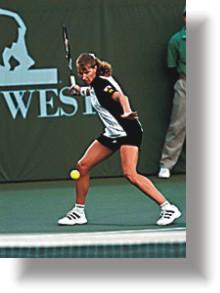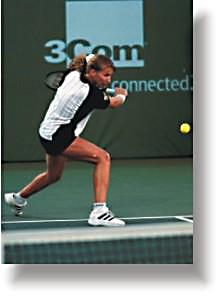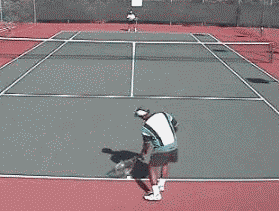|
TennisOne Lessons

Pattern Play, Part 5:
Steffi Graf's Short, Deep Game
By Monty Basnyat
TennisONE Associate Editor
The Graf Forehand
When people think of Steffi Graf, they can’t help
but picture her lethal forehand, incredible footwork, and overall
amazing athletic ability. Most of Graf’s game revolved around her forehand which she could hit with tremendous velocity and deadly accuracy. In
her prime, she could perform magic from that side and opponents would do
almost anything to keep the ball away from her forehand.
forehand which she could hit with tremendous velocity and deadly accuracy. In
her prime, she could perform magic from that side and opponents would do
almost anything to keep the ball away from her forehand.
Power,
accuracy, control, and disguise – the trade marks of the Graf
forehand. But to truly admire Graf’s game, you must appreciate her
backhand also. To the untrained eye, her backhand slice seemed nothing
more than filler as she waited for a chance to crack yet another
forehand winner. Very rarely would she come over the ball like most
other one handers do including the graceful Argentinean, Gabriella
Sabatini or the flashy Brazilian, Gustavo Kuerten. Yet, she was
extremely effective with the slice.
Graf's Slice Backhand
Graf’s slice backhand was very consistent, she
had remarkable accuracy along with astonishing depth control. She could
pound heavy, deep balls into the corners as well as float feathery,
angled short balls inside the service line, all with the same
motion. And even more importantly, she could keep the ball low. Very
rarely would an opponent get a chance to hit a Graf slice at waist
height. keep the ball low. Very
rarely would an opponent get a chance to hit a Graf slice at waist
height.
Graf’s backhand slice was the ideal stroke in the
modern era of women’s tennis where 90% or more of the players prefer the two
handed backhand and the semi-western or full western forehand. These
grips are best for hitting balls at waist level or higher. Anything at
knee and ankle level requires a deep knee bend. This is the reason her
slice was so effective - she would consistently force players to hit
balls out of their strike zone.
The Master at Creating Opportunities
Graf was a master at creating opportunities by driving
her opponents deep and wide then pulling them short
with sharp angled slices that would land around the service line. Thus
she would draw opponents into a position where they could not
effectively come in behind their shots. Opponents had to retreat, but
robbed of time, they could not always recover to a neutral position (2
–3 steps behind the baseline). Then, if Graf was given even the
slightest window to line up her forehand, they could pretty much start
thinking about the next point.
When a player has to respond to a ball below
their strike zone they tend to loose power, accuracy, and depth and
possibly court positioning. As soon as this happened Graf
would clock you with her forehand with unnerving regularity.

Watch as I first drive my opponent into the
corner then open the court for an easy winner with the short
backhand slice
|
For the twice a week club player to take advantage of this
pattern it isn't necessary to possess
Graf penetrating slice or deadly forehand. As a teaching pro, I have played, taught, charted matches, and video
taped enough club or recreational players to tell you in confidence that
the majority of weekend worriers do not move very well. So, learn to mix
up your groundies. Then, when the opportunity arises, take control of
the point by pushing your opponent
deep and wide and angle the next ball short with underspin.
If you are thinking, “I have a two handed
backhand and for the life of me, I don’t know how to hit a backhand
slice!” Once again relax; you can also play the same pattern with a
forehand slice. The forehand slice is a lot easier to start off with if
you are just learning how to hit underspin.
If you don’t know how to hit slice or underspin
from either side, I suggest you learn. Take a few lessons then partner
up with the ball machine. Before long, you’ll be very effective just
like Steffi Graf. I guarantee it! |

 forehand which she could hit with tremendous velocity and deadly accuracy. In
her prime, she could perform magic from that side and opponents would do
almost anything to keep the ball away from her forehand.
forehand which she could hit with tremendous velocity and deadly accuracy. In
her prime, she could perform magic from that side and opponents would do
almost anything to keep the ball away from her forehand.  keep the ball low. Very
rarely would an opponent get a chance to hit a Graf slice at waist
height.
keep the ball low. Very
rarely would an opponent get a chance to hit a Graf slice at waist
height.